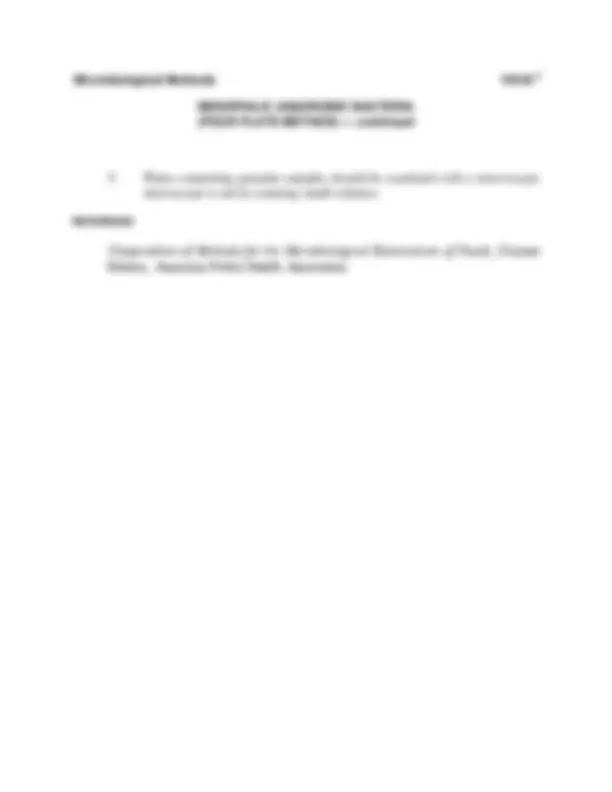



Study with the several resources on Docsity

Earn points by helping other students or get them with a premium plan


Prepare for your exams
Study with the several resources on Docsity

Earn points to download
Earn points by helping other students or get them with a premium plan
Community
Ask the community for help and clear up your study doubts
Discover the best universities in your country according to Docsity users
Free resources
Download our free guides on studying techniques, anxiety management strategies, and thesis advice from Docsity tutors
The procedure for quantitating viable anaerobic bacteria in samples from the corn wet milling industry using the pour plate method under anaerobic conditions. The method is applicable to starches, syrups, sugars, and most co-products. Special apparatus, media, and reagents are required, and caution must be exercised due to potential pathogenicity of isolates.
Typology: Study notes
1 / 3

This page cannot be seen from the preview
Don't miss anything!


Microbiological Methods of the Member Companies of the Corn Refiners Association Accepted 03-30- Revised 02-01-
MESOPHILIC ANAEROBIC BACTERIA (POUR PLATE METHOD)
PRINCIPLE
Viable anaerobic bacteria are quantitated by the fractional gram pour plate technique under an anaerobic atmosphere. Caution must be exercised when applying the method since isolates may be pathogenic.
SCOPE
The method is applicable to starches, syrups, sugars and most co-products of the corn wet milling industry.
SPECIAL APPARATUS
Anaerobic jars, BBL GasPak or equivalent, equipped with GasPak hydrogen and CO 2 generator envelopes with an anaerobic indicator.
MEDIA AND REAGENTS
Stock Solution: Dissolve 34 g of potassium dihydrogen phosphate (KH 2 PO 4 ) in 500 mL of purified water, adjust to pH 7.2 with about 175 mL of 1 N NaOH solution and dilute to 1 L volume. Store under refrigeration.
Diluent: Dilute 1.25 mL of stock solution to 1 L volume with purified water. Prepare dilution blanks using this solution.
MESOPHILIC ANAEROBIC BACTERIA (POUR PLATE METHOD) ⎯ continued
PROCEDURE
Aseptically weigh 20 g of sample into a sterile 80 mL water blank and homogenize (Note 3). This is the primary dilution and represents a sample dilution factor of 5. Twenty mL of the primary dilution can be aseptically transferred to another 80 mL water blank, and the sample is diluted by a factor of
Pipet 1.0 mL (Note 4) of each sample dilution into duplicate Petri dishes. Pour 20-25 mL of ANA agar which has been cooled to 45°C into each dish. Swirl plates and allow to solidify. Immediately after solidification invert the plates and place them in an anaerobe jar. Following manufacturer's directions, generate the anaerobic atmosphere.
Incubate the anaerobe jar at 35-37°C for 48-72 hrs. (2-3 days). Count the number of colonies on those plates showing 25-250 colonies (Note 5). Average the count of the duplicate plates, multiply by the dilution factor and record as the number of anaerobic bacteria per gram. If the lowest dilution shows less than 25 colonies, then these colonies must be counted and reported.
CALCULATION
Number of anaerobic bacteria per gram = Average number of anaerobic bacteria x Dilution factor
NOTES AND PRECAUTIONS